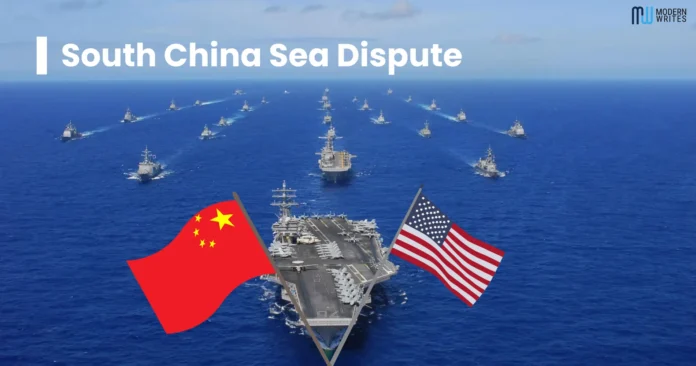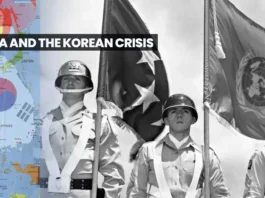Introduction of South China Sea Dispute
Brunei, Indonesia, Malaysia, the Philippines, Taiwan, and Vietnam are all irritated by China’s broad assertions of sovereignty over the sea, which threaten their access to the sea’s projected 11 billion barrels of undiscovered oil and 190 trillion cubic feet of natural gas. States have been staking claims to territory and islands in the South China Sea, including the resource-rich Spratly Islands, since at least the 1970s.
Beijing claims that the EEZ is off-limits to foreign military intelligence collecting operations, including surveillance planes, due to international law. The USA asserts that under UNCLOS, all nations with maritime claims have unfettered access to each other’s Exclusive Economic Zones (EEZs) and need not provide advance notice of armed forces operations. The Permanent Court of Arbitration in The Hague published its decision on an argument made against Beijing under UNCLOS by the Philippines in July 2016, finding the Philippines side on nearly all counts. China signed the accord that created the tribunal, but it still fails to acknowledge the tribunal’s competence. South China Sea Dispute
China has been actively expanding the extent of the current islands and constructing new ones in the South China Sea in recent years, as seen by satellite photography. Specifically in the Paracel and Spratly Islands, where it has twenty-seven bases, Beijing has built harbors, military structures, and airstrips by adding sand over existing reefs. China has installed fighter planes, cruise missiles, and a radar system on Woody Island, thereby turning it into a military outpost. South China Sea Dispute
The USA has conducted FONOPs and bolstered assistance for Southeast Asian partners to fight the Chinese’s assertive territorial assertions and land reclamation attempts with the goal of preserving its economic, security, and political goals in the area. Tokyo has also provided military ships and equipment to the Philippines and Vietnam in reply to Beijing’s forceful buildup in the contentious zone, with the stated goals of bolstering maritime security and discouraging further Chinese aggression.
The situation between China and the Philippines is deteriorating, and scheduled joint navy drills among the United States, Australia, and Japan have brought this confrontation back into the spotlight. Presently, on Tuesday in the contentious South China Sea, two Philippine boats broke through a Chinese coast guard blockade in a risky clash to provide foodstuffs and other commodities to Filipino marines holding a contested shoal. However, at least four Chinese coast guard ships halted two Philippine coast guard vessels escorting the supply boats for almost five hours in the tense standoff near Second Thomas Shoal.
Monday night marked the beginning of the fighting when a Chinese coast guard ship began following the Philippine ships. At one point on Tuesday morning, a man claiming to be from one of the Chinese coast guard ships radioed the other side and said, “To avoid miscalculation, leave and keep out; otherwise, you will bear full responsibility for all the consequences.” South China Sea Dispute
Filipino security officials
Filipino security officials said on Sunday that Washington, Tokyo, and Canberra were arranging an integrated maritime drill in the South China Sea off the western Philippines this week to demonstrate their support for the rule of law in the area following a recent display of Chinese conduct in the area of contention.
In the disputed waterway, where disagreements have long been seen as an imminent hotspot and have constituted a point of friction in the competition between the United States and PRC in the area, Chinese navy vessels deployed water cannons against Philippine ships on August 5. Whilst asked approximately the opportunity of a navy assault on Philippine territory or navy ships everywhere in the international, together with the South China Sea, the united states government reiterated its commitment to shield its historic treaty companion. South China Sea Dispute
ASEAN South China Sea Dispute
The affiliation of Southeast Asian countries (ASEAN) is trying to mediate tensions between its member states and China in the South China Sea. The periodic territorial spats in the bustling South China Sea were agreed to be avoided by China and Southeast Asian states Thursday by agreeing to attempt to finalize by three years a long-delayed nonaggression treaty. A Southeast Asian diplomat involved in the talks said that China and the 10-nation ASEAN bloc agreed to guidelines on Thursday to finish their code of conduct talks before fall 2026 during an encounter between the 10-nation bloc’s foreign ministers and the Chinese highest official, Wang Yi, in the Indonesian capital of Jakarta.
China and ASEAN made a non-binding agreement in 2002, but it has not stopped the occupancy of uninhabited islands and reefs by opposing claimant states. A shared committee between China and ASEAN “must try to wrap up the discussion of an efficient and comprehensive code of conduct that is consistent with international law, including the 1982 U.N. South China Sea Dispute
Convention on the Law of the Sea, within a 3-year timeframe or before,” as stated in the instructions. Whether or not the region’s charter should be legally binding and the breadth of its application were two of the most controversial problems, and the regulations required further discussions between the two parties to discuss them.
Conclusion South China Sea Dispute
In the end, China has been able to dictate the pace and approach to resolving the disputes because of the imbalance of power between the two countries. For example, China has delayed the DOC’s implementing guidelines for years, downplayed the importance of the issue to the Philippines and Vietnam, refused to bring the issue to other possible arenas for intervention, such as the ARF, and played a divide and rule game within ASEAN to increase its advantage. South China Sea Dispute
And despite America’s best efforts to preserve its sway in the South China Sea (SCS), its authoritarian attitude has prevented regional governments from sitting down to negotiate with one another. However, neither China nor any other regional power wants the situation to get worse. They need to utilize the ASEAN and ARF as springboards to negotiate a safe middle ground. China, as a regional powerhouse, has an obligation to work with the group. South China Sea Dispute




